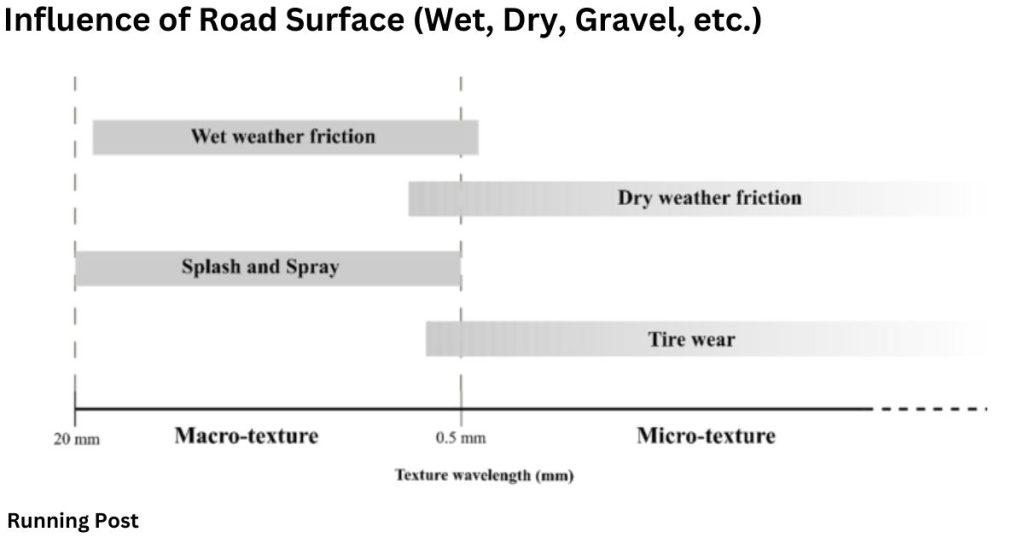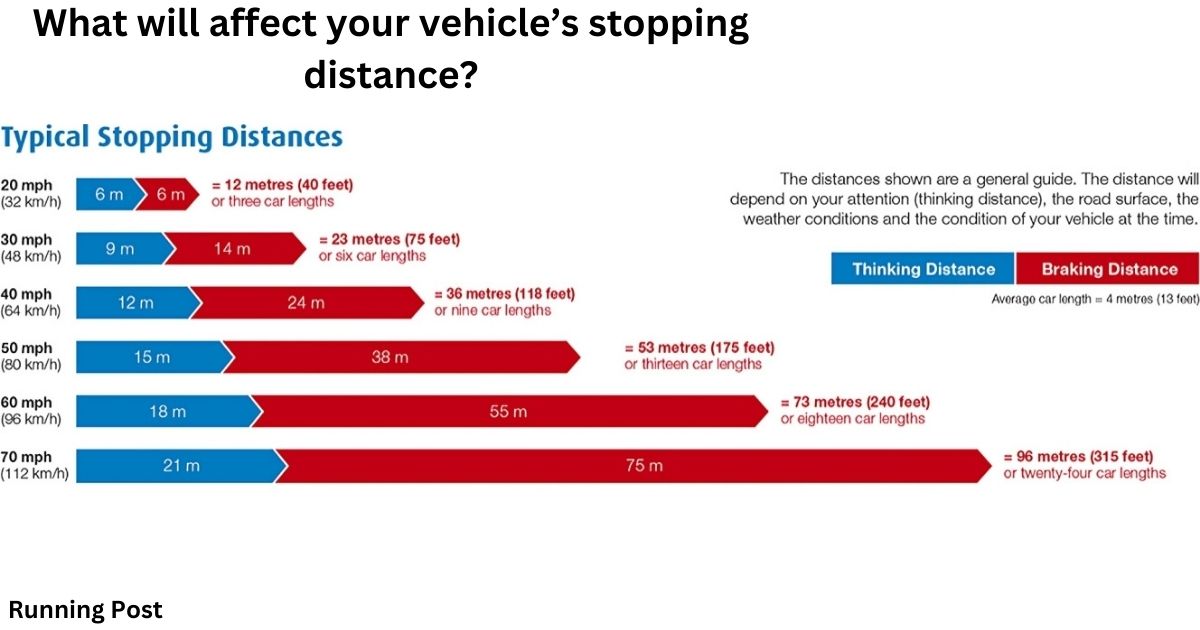| A: The condition of the tyres | B: The speed limit | C: The Color of Your Vehicle | D: The Brand of Fuel You Use |
Understanding Vehicle Stopping Distance
Introduction
What will affect your vehicle’s stopping distance? Vehicle stopping distance is the total distance a vehicle covers from the moment the driver perceives a need to stop until the vehicle comes to a complete stop. It consists of two parts: thinking distance and braking distance. Thinking distance is the distance traveled while the driver reacts to a hazard, and braking distance is the distance traveled while the vehicle is braking. Understanding stopping distance is crucial for safe driving as it helps in making informed decisions, especially in emergency situations.
Points to Note:
- Stopping Distance Components: Includes thinking distance and braking distance.
- Importance of Awareness: Helps in adjusting driving habits and enhancing safety.
- Impact on Safety: Directly affects the ability to avoid collisions.
Definition of Stopping Distance
Stopping distance is the combined distance of thinking and braking. The thinking distance is how far the vehicle travels while the driver perceives and reacts to a hazard. Braking distance is the distance required for the vehicle to stop once the brakes are applied. Both distances together determine the overall stopping distance, which varies based on speed, road conditions, and driver response.
Points to Note:
- Components of Stopping Distance: Thinking distance and braking distance.
- Impact Factors: Speed, road conditions, and driver reaction.
- Calculation: Total stopping distance = thinking distance + braking distance.
Key Factors Influencing Stopping Distance
Several factors affect stopping distance, including tyre condition, road surface, weather, vehicle load, braking system, and speed. Each factor plays a role in how quickly a vehicle can come to a stop. Managing these factors effectively can improve stopping performance and road safety.
Points to Note:
- Factors Affecting Stopping Distance: Tyres, road surface, weather, load, brakes, speed.
- Role of Each Factor: Each influences the distance needed to stop.
- Management Importance: Proper management enhances stopping safety.
The Condition of the Tyres
How Tyre Quality Impacts Braking Efficiency
Tyre quality significantly impacts braking efficiency. High-quality tyres with sufficient tread depth provide better grip, improving the vehicle’s ability to stop quickly. Good tyres enhance traction on different surfaces, reducing the stopping distance. Worn-out or poor-quality tyres can lead to longer stopping distances and increased accident risk.
Points to Note:
- Tyre Quality: Affects braking performance.
- Grip and Traction: Better tyres mean improved stopping ability.
- Safety Risk: Poor-quality tyres increase stopping distance and accident risk.
Importance of Tread Depth and Tyre Pressure
Proper tread depth and tyre pressure are crucial for effective braking. Adequate tread helps channel water away and maintains grip, while correct pressure ensures optimal contact with the road. Under-inflated or over-inflated tyres can cause uneven wear and reduced traction, increasing stopping distance.
Points to Note:
- Tread Depth: Essential for maintaining grip and preventing hydroplaning.
- Tyre Pressure: Affects tyre contact and braking efficiency.
- Regular Checks: Prevents uneven wear and ensures safety.
Road Conditions
Influence of Road Surface (Wet, Dry, Gravel, etc.)

The road surface has a significant impact on stopping distance. On wet or icy roads, or on gravel, the vehicle’s grip is reduced, leading to longer stopping distances. Dry, well-maintained surfaces provide better traction, allowing for shorter stopping distances.
Points to Note:
- Road Surface Types: Wet, dry, gravel, etc.
- Effect on Grip: Reduced grip increases stopping distance.
- Driving Adjustments: Adapt speed according to road conditions.
Effects of Road Incline or Decline
Road inclines and declines affect how quickly a vehicle can stop. Uphill roads can increase stopping distance due to reduced vehicle speed, while downhill roads can decrease stopping distance but increase the risk of skidding. Adjustments in driving are necessary to accommodate these conditions.
Points to Note:
- Incline Effects: Uphill increases stopping distance.
- Decline Effects: Downhill decreases stopping distance but increases skid risk.
- Driving Adjustments: Necessary for safe stopping on inclines or declines.
How Road Maintenance Affects Stopping Distance
Road maintenance, including potholes, cracks, and debris, can influence stopping distance. Poorly maintained roads can cause sudden changes in traction and stability, leading to longer stopping distances. Regular road upkeep ensures safer driving conditions and shorter stopping distances.
Points to Note:
- Maintenance Issues: Potholes, cracks, debris.
- Impact on Traction: Can lead to unexpected changes in grip.
- Safety Importance: Regular maintenance enhances driving safety.
Weather Conditions
Impact of Rain, Snow, and Ice on Braking Performance
Weather conditions like rain, snow, and ice significantly impact braking performance. These conditions reduce tyre traction, leading to longer stopping distances. Drivers should adjust their speed and increase following distances during adverse weather to compensate for reduced braking efficiency.
Points to Note:
- Weather Impact: Reduces traction and increases stopping distance.
- Traction Loss: Rain, snow, ice decrease grip.
- Driving Adjustments: Increase speed and following distances.
Adjusting Driving Habits in Adverse Weather
In adverse weather, drivers should modify their driving habits to ensure safety. Reducing speed, increasing following distance, and avoiding sudden maneuvers can help compensate for longer stopping distances. Proper vehicle maintenance is also crucial to handle weather-related challenges effectively.
Points to Note:
- Driving Adjustments: Reduce speed and increase following distance.
- Avoid Sudden Moves: Helps maintain control and reduces stopping distance.
- Maintenance Importance: Ensures vehicle performance in bad weather.
Vehicle Load
How Additional Weight Affects Stopping Distance
Additional weight increases stopping distance because it adds to the vehicle’s momentum. Heavier vehicles require more distance to stop as the braking system has to work harder to decelerate. Proper load management and avoiding excessive weight can help maintain safer stopping distances.
Points to Note:
- Weight Impact: Increased weight extends stopping distance.
- Braking System Stress: Heavier loads stress brakes more.
- Load Management: Essential for maintaining safe stopping distances.
Effects of Load Distribution and Cargo
How cargo is distributed affects stopping distance. Improperly distributed loads can impact vehicle balance and braking efficiency, leading to longer stopping distances. Ensuring even load distribution and securing cargo can help improve vehicle stability and stopping performance.
Points to Note:
- Load Distribution: Affects vehicle balance and braking.
- Cargo Security: Ensures stability and effective stopping.
- Braking Efficiency: Proper distribution improves performance.
Braking System Condition
Importance of Brake Pad Wear and Brake Fluid Levels
The condition of brake pads and brake fluid is crucial for effective stopping. Worn brake pads can lead to reduced braking power, while low brake fluid levels can affect brake performance. Regular maintenance and timely replacements of brake components ensure optimal stopping distances.
Points to Note:
- Brake Pad Condition: Affects braking power.
- Brake Fluid Levels: Critical for effective brake operation.
- Regular Maintenance: Ensures proper brake performance.
How Well-Maintained Brakes Improve Stopping Distance
Well-maintained brakes ensure that a vehicle can stop efficiently and safely. Regularly checking and servicing the braking system helps maintain its effectiveness, resulting in shorter stopping distances and enhanced safety on the road.
Points to Note:
- Brake Maintenance: Improves stopping efficiency.
- Servicing Benefits: Ensures effective braking.
- Safety Enhancement: Shortens stopping distances.
Speed of the Vehicle
Relationship Between Speed and Stopping Distance
Speed has a direct relationship with stopping distance. As speed increases, the stopping distance grows exponentially. Higher speeds require significantly more distance to stop, making it crucial for drivers to adjust their speed according to road conditions and traffic.
Points to Note:
- Speed Impact: Higher speed increases stopping distance.
- Exponential Growth: Stopping distance grows more with speed.
- Speed Adjustment: Essential for safe driving.
How Speed Affects the Time and Distance Required to Stop
Speed affects both the time and distance required for a vehicle to stop. Higher speeds mean more time and distance are needed to bring the vehicle to a halt. Drivers should be aware of this and allow ample distance for stopping, especially in high-speed conditions.
Points to Note:
- Stopping Time: Increases with higher speed.
- Stopping Distance: Also grows with speed.
- Distance Allowance: Necessary for safe stopping.
You Also Like It:
How would under-inflated tyres affect your vehicle?
Which driving technique can help you save fuel?
What Are the Factors Affecting Stopping Distances of a Vehicle?
Summary of Primary Factors Affecting Stopping Distance
The primary factors affecting stopping distance include tyre condition, road surface, weather, vehicle load, braking system, and speed. Each of these factors contributes to how quickly a vehicle can stop, and understanding their effects is crucial for safe driving.
Points to Note:
- Primary Factors: Tyres, road surface, weather, load, brakes, speed.
- Contribution to Stopping Distance: Each factor plays a role.
- Importance of Understanding: Enhances driving safety.
Interaction Between Various Factors
Factors affecting stopping distance do not work in isolation; they interact with each other. For example, poor tyre condition can exacerbate the effects of wet roads, and heavy loads can worsen the impact of worn brakes. Understanding these interactions helps drivers make better safety decisions.
Points to Note:
- Factor Interaction: Factors influence each other.
- Example: Poor tyres on wet roads.
- Safety Decisions: Better understanding improves safety.
What Affects Your Overall Stopping Distance?
Combining the Effects of Different Factors
Overall stopping distance is the result of combining the effects of various factors, such as tyre condition, road surface, weather, and speed. By managing these factors effectively, drivers can reduce their stopping distance and enhance road safety.
Points to Note:
- Combined Effects: Tyres, road, weather, speed.
- Effective Management: Reduces stopping distance.
- Safety Enhancement: Improves overall driving safety.
Importance of Regular Vehicle Maintenance for Safety
Regular vehicle maintenance is essential for ensuring that all components affecting stopping distance are in optimal condition. Routine checks and servicing of tyres, brakes, and other critical systems help maintain effective stopping distances and enhance overall driving safety.
Points to Note:
- Maintenance Importance: Ensures optimal component performance.
- Routine Checks: Essential for safety.
- Effective Stopping: Regular maintenance improves stopping distance.
What Factors Affect the Distance It Takes to Stop?
In-Depth Look at Each Factor and Its Contribution to Stopping Distance
Each factor affecting stopping distance contributes differently. For instance, speed impacts stopping distance exponentially, while tyre condition directly influences grip. An in-depth understanding of each factor helps drivers manage their vehicle’s stopping performance more effectively.
Points to Note:
- Individual Contributions: Speed, tyres, road, etc.
- Detailed Understanding: Helps in managing stopping performance.
- Effective Management: Improves safety.
Real-Life Examples and Scenarios
Real-life scenarios illustrate how different factors affect stopping distance. For example, a driver on a wet road with worn tyres may experience a significantly longer stopping distance compared to driving on a dry road with well-maintained tyres. These examples highlight the importance of considering all factors for safe driving.
Points to Note:
- Examples: Wet road with worn tyres vs. dry road with good tyres.
- Scenario Illustration: Shows impact of various factors.
- Safety Reminder: Importance of managing all factors.
Conclusion About What will affect your vehicle’s stopping distance?
Recap of Key Points
Understanding and managing the factors that affect stopping distance is crucial for safe driving. Key factors include tyre condition, road surface, weather, vehicle load, braking system, and speed. By being aware of these factors and their interactions, drivers can improve their ability to stop safely.
Points to Note:
- Key Factors Recap: Tyres, road, weather, load, brakes, speed.
- Importance: Enhances stopping safety.
- Driver Awareness: Crucial for safe driving.
Tips for Maintaining Optimal Stopping Distance
To maintain optimal stopping distance, drivers should regularly check tyre condition, adjust driving habits based on road and weather conditions, manage vehicle load effectively, and ensure their braking system is well-maintained. Safe driving practices and vehicle maintenance are key to ensuring a shorter and safer stopping distance.
Points to Note:
- Regular Checks: Tyres, brakes, load.
- Driving Adjustments: Based on conditions.
- Maintenance: Ensures effective stopping distance.
You Also Like It:
Where should you park your vehicle at night?

